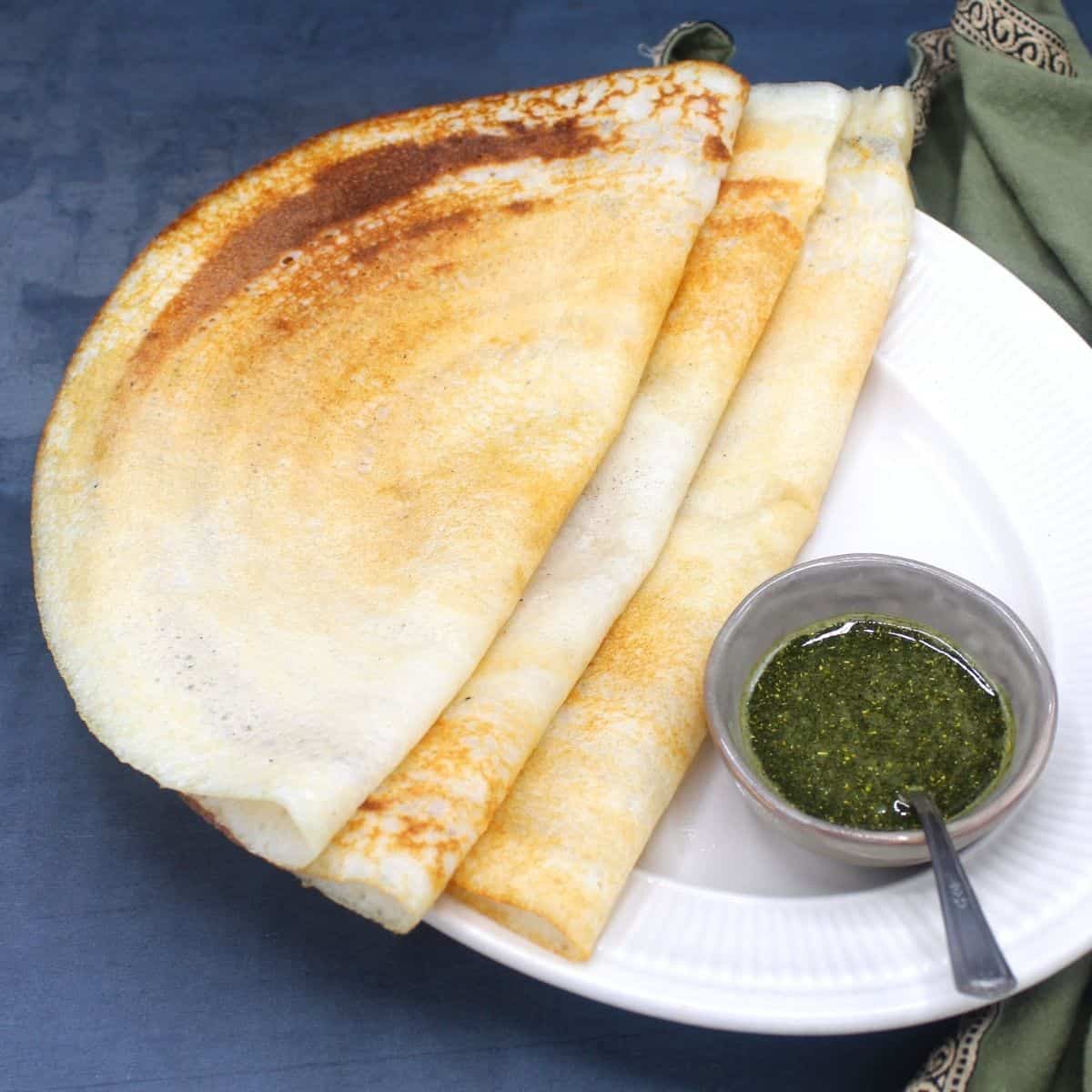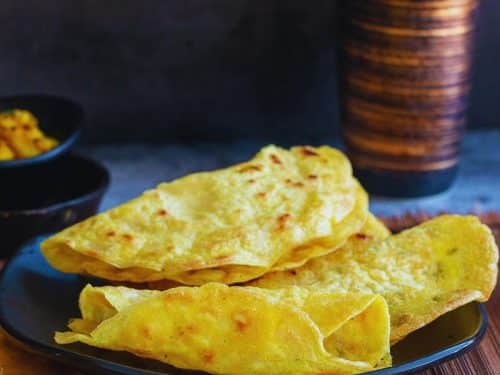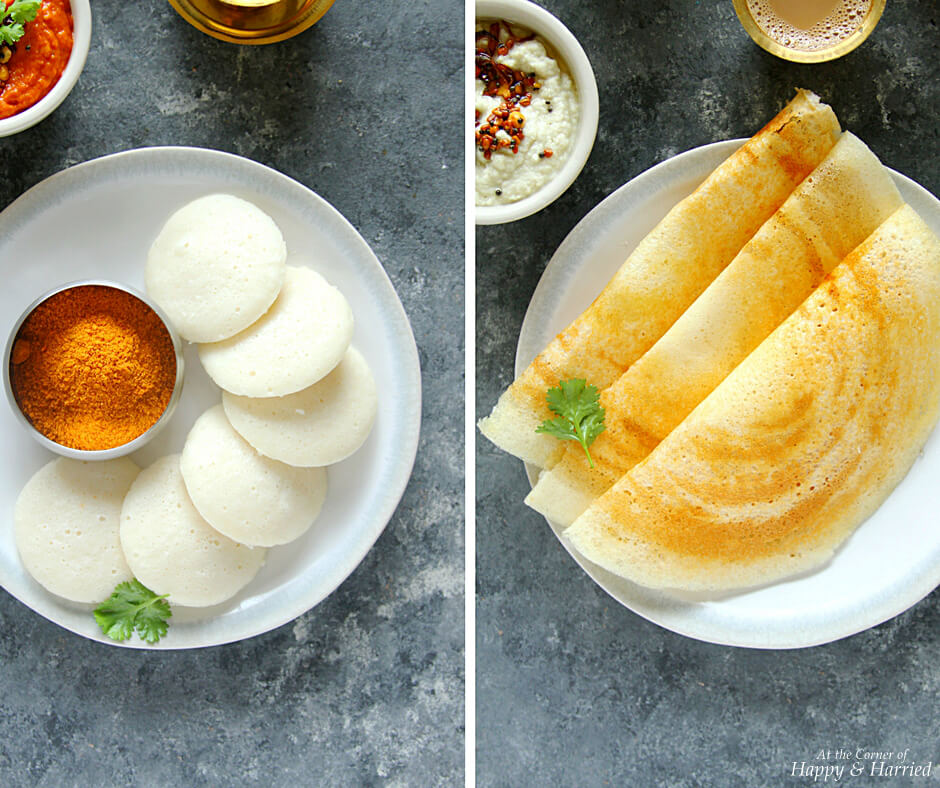
Introduction
South Indian cuisine is known for its variety of flavors and unique dishes. One such popular dish is the dosa, a thin and crispy rice and lentil crepe. Dosas are typically enjoyed with coconut chutney and sambar, and they make for a delicious and satisfying meal. However, one common problem with leftover dosas is that they tend to lose their crispiness. In this blog post, we will explore a solution to this problem and share a recipe for the crispiest dosas you’ve ever tasted.
The Dosa: A Popular South Indian Dish
Dosa is a staple in South Indian cuisine, enjoyed for breakfast, lunch, or dinner. It is made from a fermented batter consisting of rice and lentils, which is spread thinly on a hot griddle and cooked until crispy. The dosa can be enjoyed plain or stuffed with various fillings like spiced potatoes, onions, or cheese. Its versatility and delicious taste have made it a favorite among many.
The Problem: Leftover Dosas Losing Crispiness
While freshly made dosas are crispy and flavorful, leftovers tend to lose their crispiness when reheated. This can be disappointing for dosa lovers who enjoy the crispy texture. The reheating process often results in a softer and less appetizing dosa. However, there is a simple solution to revive the crispiness of leftover dosas.
By following a few steps and using the right technique, you can enjoy the same level of crispiness in reheated dosas. One method is to rinse the dosa quickly in water for a few seconds and then heat it in a dosa pan on both sides. Another technique is to reheat the dosas in the oven using the bake setting for about two minutes. These methods help to restore the desired crispiness and make the dosas as enjoyable as they were when freshly made.
In conclusion, dosas are a beloved South Indian dish that can be enjoyed in various ways. Whether you are having freshly made dosas or reheating leftovers, there are methods to ensure the dosas remain crispy and delicious. By following the steps shared in this blog post, you can enjoy the crispiest dosas that will leave you wanting more. So go ahead and savor the flavors of this popular South Indian delicacy.
Why Crispiness Matters In Dosas
The Appeal Of A Crispy Dosa
A crispy dosa is not only visually appealing but also adds to the overall taste and experience of eating this South Indian delicacy. The golden-brown color and the satisfying crunch are what make dosas so irresistible. Without the crispiness, a dosa can feel limp and lackluster, failing to deliver the desired satisfaction.
The Importance Of Texture In Food
Texture plays a crucial role in our enjoyment of food. It adds depth and dimension to the eating experience and can make even the simplest dish more enjoyable. In the case of dosas, the contrast between the crispy exterior and the soft interior creates a delightful texture that keeps us coming back for more. The crispiness adds a satisfying bite that enhances the flavors of the dosa and provides a delightful mouthfeel.
To achieve the perfect crispiness in dosas, it is essential to pay attention to factors such as the quality of the dosa batter and the cooking technique. Properly fermented batter is key to achieving the desired texture and color in a dosa. The fermentation process allows for the growth of beneficial bacteria, which not only adds flavor but also contributes to the crispiness of the dosa.
Additionally, cooking the dosa on medium-high heat initially and then reducing the heat slightly helps to balance the cooking process and achieve the desired crispiness without burning the dosa. This two-step cooking technique ensures that the dosa is cooked evenly and develops the coveted golden-brown color.
In conclusion, crispiness is an essential aspect of enjoying dosas. It adds visual appeal, enhances the eating experience, and contributes to the overall satisfaction of indulging in this popular South Indian dish. By following the tips and techniques mentioned earlier, you can master the art of making perfectly crispy dosas that will leave you craving for more. So, go ahead and take your dosa game to the next level by achieving the desired crispiness every time you make this delicious dish.
Methods To Reheat Dosas
Reheating With A Tawa (stovetop)
To reheat dosas using a tawa (stovetop), follow these simple steps:
- Heat a tawa (griddle) over medium heat and make sure it is evenly heated.
- Place the dosa on the heated tawa and let it warm up for about 30 seconds.
- Flip the dosa and let it warm up for another 30 seconds on the other side.
- If you like your dosas extra crispy, you can cook them for a little longer on each side until they reach the desired level of crispiness.
- Once the dosa is warmed up and crispy, remove it from the tawa and serve hot.
Reheating With A Microwave
Reheating dosas using a microwave can be a quick and convenient method. Here’s how you can do it:
- Place the dosa on a microwavable plate and cover it with a microwave-safe cover or microwave-safe paper towel to retain moisture.
- Microwave the dosa on high power for 30 seconds to 1 minute, depending on the thickness of the dosa and the microwave wattage.
- Check the dosa’s temperature and crispiness. If it needs more heating, microwave it in 10-second intervals until it reaches the desired warmth and texture.
- Once heated, remove the dosa from the microwave and serve immediately.
It’s important to note that reheating dosas in the microwave may result in a slightly softer texture compared to reheating on a tawa. However, the microwave method is still effective in regaining the crispiness if done correctly.
In conclusion, whether you choose to reheat dosas using a tawa or a microwave, both methods can help you regain the crispy texture of leftover dosas. Choose the method that suits your convenience and enjoy your dosas hot and crispy just like freshly made ones!

Reheating Dosas On A Tawa
Step-by-step Guide To Reheating Dosas On A Tawa
To reheat dosas using a tawa (stovetop), follow these simple steps:
- Heat a tawa (griddle) over medium heat and make sure it is evenly heated.
- Place the dosa on the heated tawa and let it warm up for about 30 seconds.
- Flip the dosa and let it warm up for another 30 seconds on the other side.
- If you like your dosas extra crispy, you can cook them for a little longer on each side until they reach the desired level of crispiness.
- Once the dosa is warmed up and crispy, remove it from the tawa and serve hot.
Tips And Tricks For Crispy Dosas
- Clean the tawa surface using a kitchen towel before placing the dosa to avoid sticking.- Make sure the tawa is evenly heated to prevent uneven reheating.- Flip the dosa gently to maintain its shape and prevent tearing.- If you prefer a softer dosa, you can reduce the heating time on each side.- Experiment with different levels of crispiness to find your preferred texture.- Serve the reheated dosa immediately to enjoy it hot and crispy.
Reheating dosas on a tawa provides a traditional method that helps regain the crispy texture of leftover dosas. It allows the dosa to be heated evenly, maintaining its shape and texture. The method is simple and convenient, especially for those who prefer a crispy dosa. With a few tips and tricks, you can ensure your reheated dosas are as delicious as freshly made ones.
Please note that reheating dosas on a tawa might require a bit more time and effort compared to the microwave method. However, if you enjoy the process of cooking and find joy in using traditional methods, reheating dosas on a tawa is the way to go. With practice, you can master the art of perfectly reheated dosas that are crispy, flavorful, and satisfying.
Reheating Dosas In A Microwave
Step-by-step Guide To Reheating Dosas In A Microwave
To reheat dosas using a microwave, follow these simple steps:
- Place the dosa on a microwave-safe plate.
- Cover the dosa loosely with a microwave-safe lid or microwave-safe plastic wrap to prevent splatters.
- Heat the dosa on medium power for about 30 to 45 seconds.
- Check the dosa for desired warmth and crispiness. If it needs more time, heat it for an additional 10 seconds at a time until it reaches the desired texture.
Dos And Don’ts For Microwaving Dosas
Dos:
- Use a microwave-safe plate and cover to prevent mess and retain moisture.
- Heat the dosa on medium power to ensure even reheating without overcooking.
- Check the dosa regularly to avoid burning or overheating.
Don’ts:
- Avoid using high power settings, as they can make the dosa rubbery.
- Don’t forget to cover the dosa to prevent splatters and maintain moisture.
Microwaving dosas provides a quick and convenient method for reheating them. It is especially suitable for those who prefer a softer dosa with less crispiness. However, microwaving may not give the dosa the same level of crispiness as reheating on a tawa. The dosa may turn out slightly softer and less textured compared to the tawa method.
It’s important to note that the microwave method is not recommended for reheating large batches of dosas as it may result in uneven heating. If you’re reheating multiple dosas, it’s better to use the tawa method for better results.
In conclusion, whether you choose to reheat dosas on a tawa or in a microwave, both methods can be effective in regaining the crispy texture of leftover dosas. Consider your preferences and time constraints to decide which method suits you best. Experiment with different heating times and techniques to achieve your desired level of crispiness and enjoy your reheated dosas hot and delicious.
The Fresh Vs. Reheated Dosa Debate
Fresh Dosas: The Ultimate Crispy Experience
Freshly made dosas are known for their incredible crispiness and delightful texture. Served hot off the tawa, they offer a true culinary experience. The dosa is thin, perfectly golden, and has a satisfying crunch with every bite. The flavors are vibrant, and the dosa is at its peak in terms of taste and presentation. Being made to order, fresh dosas can be customized with various fillings and accompaniments, making each eating experience unique and delicious.
Reheated Dosas: A Convenient Solution
Reheating dosas is a practical solution for those who want to enjoy the flavors of a dosa without going through the entire cooking process. There are various methods to reheat dosas, such as using a microwave or a tawa. Microwaving dosas takes only a few seconds and is convenient for quick meals. While the dosa may lose a bit of its crispiness, it still retains its flavors and can be enjoyed with your favorite chutneys or fillings.
Using a tawa to reheat dosas is another popular method. By heating the dosa on a dosa pan or griddle, you can regain some of the original crispiness. This method takes a bit more time but results in a dosa that closely resembles its freshly made counterpart. Simply heat the dosa for a few minutes on medium heat, and you’ll have a warm and crispy dosa to savor.
Both fresh and reheated dosas have their own merits. If you’re someone who values the ultimate crispiness and texture, then fresh dosas are the way to go. However, if convenience and time-saving are your priorities, reheating dosas is a viable option that still allows you to enjoy the flavors of a dosa.
In the end, the choice between fresh and reheated dosas comes down to personal preference and circumstances. Some may argue that nothing can beat the taste of a fresh dosa, while others may appreciate the convenience of reheated dosas. Whichever method you choose, dosas are a delightful and versatile dish that can be enjoyed in various ways. So, go ahead and relish your dosa, whether it’s fresh off the tawa or reheated to perfection.
How To Store Cooked Dosas
Proper Cooling And Storage Techniques
If you have leftover cooked dosas, it is important to handle them properly to maintain their quality and extend their shelf life. Here are some guidelines:
- Wrap the cooked dosas in aluminum foil or place them in an airtight container before storing them in the refrigerator.
- It is recommended to consume the dosas within a day for the best flavor and texture.
- Avoid leaving the dosas at room temperature for extended periods as this can lead to bacterial growth and spoilage.
Best Practices For Preserving Dosa Freshness
To maximize the freshness of your dosas, follow these tips:
- Store the dosa batter in an airtight container to prevent moisture loss and maintain its quality.
- If you have extra dosa batter, divide it into smaller portions and store them in freezer-safe containers in the freezer.
- When you are ready to use the frozen dosa batter, transfer it to the refrigerator to thaw for approximately 24 hours beforehand.
By following these storage guidelines and best practices, you can enjoy delicious and crisp dosas even after they are cooked. Whether you prefer freshly made dosas or reheated ones, the choice ultimately depends on your personal preference and circumstances. Fresh dosas offer the ultimate crispy experience with vibrant flavors, while reheated dosas provide convenience without compromising on taste. Experiment with both methods and find what suits you best.

Frequently Asked Questions About Reheating Dosas
Can You Freeze Dosas?
Yes, you can freeze dosas to extend their shelf life. Here’s how:
- Make sure the dosas are completely cooled before freezing them.
- Place each dosa in a separate freezer-safe bag or wrap them individually in aluminum foil.
- Label the bags with the date and contents before placing them in the freezer.
- When you want to reheat the dosas, remove them from the freezer and allow them to thaw in the refrigerator overnight.
- To reheat the thawed dosas, you can either use a microwave or a pan. If using a pan, heat it on medium-low heat and place the dosa on it until it becomes warm and crispy.
However, it’s important to note that freezing dosas may slightly affect their texture. While they will still be tasty, they may not be as crispy as freshly made dosas.
How Long Can You Store Cooked Dosas?
Cooked dosas should be consumed within a day for the best flavor and texture. Storing them in the refrigerator in an airtight container or wrapped in aluminum foil helps maintain their freshness.
Avoid leaving the dosas at room temperature for longer periods as this can lead to bacterial growth and spoilage. It’s recommended to either refrigerate them or use them immediately.
If you have leftover dosa batter, it can be stored in an airtight container in the refrigerator for up to 2-3 days. Make sure to give it a good mix before using it to make dosas.
Leftover idlis can also be stored in the fridge overnight. To reheat them, gently warm them in the microwave or in a steamer vessel.
Proper storage and handling techniques are essential to ensure the quality and safety of leftover dosas. By following these guidelines, you can enjoy delicious dosas even after they are cooked.
Frequently Asked Questions About Reheating Dosas
Can Dosas Be Frozen?
Yes, dosas can be frozen to extend their shelf life. Here’s a step-by-step guide on how to freeze dosas:
- Make sure the dosas are completely cooled before freezing them.
- Place each dosa in a separate freezer-safe bag or wrap them individually in aluminum foil.
- Label the bags with the date and contents before placing them in the freezer.
- When you want to reheat the dosas, remove them from the freezer and allow them to thaw in the refrigerator overnight.
- To reheat the thawed dosas, you can either use a microwave or a pan. If using a pan, heat it on medium-low heat and place the dosa on it until it becomes warm and crispy.
However, it’s important to note that freezing dosas may slightly affect their texture. While they will still be tasty, they may not be as crispy as freshly made dosas.
How Long Can Cooked Dosas Be Stored?
Cooked dosas should be consumed within a day for the best flavor and texture. Storing them in the refrigerator in an airtight container or wrapped in aluminum foil helps maintain their freshness.
Avoid leaving the dosas at room temperature for longer periods as this can lead to bacterial growth and spoilage. It’s recommended to either refrigerate them or use them immediately.
If you have leftover dosa batter, it can be stored in an airtight container in the refrigerator for up to 2-3 days. Make sure to give it a good mix before using it to make dosas.
Leftover idlis can also be stored in the fridge overnight. To reheat them, gently warm them in the microwave or in a steamer vessel.
Proper storage and handling techniques are essential to ensure the quality and safety of leftover dosas. By following these guidelines, you can enjoy delicious dosas even after they are cooked.
Conclusion
Achieving Crispy Dosas Again: A Summary
Dosas, with their superb crunch and delicate flavor, are a show-stopper of Indian cooking. Achieving the perfect dosa requires the right ingredients, equipment, and a bit of patience and practice. Proper fermentation of the dosa batter is crucial for achieving irresistibly crispy dosas.
Experimenting With Reheating Methods And Enjoying The Results
Reheating dosas can be done using various methods, such as using a microwave or a pan. Freezing dosas can help extend their shelf life, but they may not be as crispy as freshly made ones. Storing cooked dosas in the refrigerator and reheating them properly can help maintain their flavor and texture.
By following the tips and techniques mentioned in this article, you can enjoy crispy and flavorful dosas even after reheating them.
Frequently Asked Questions (FAQs) about How to Reheat Dosa: Reviving the Crispiness in Leftover Dosas
Q: Can I reheat leftover dosas to restore their crispiness?
A: Yes, you can! Reheating dosas is a great way to enjoy their crispy texture again.
Q: What is the best method to reheat dosas?
A: The best way to reheat dosas and retain their crispiness is by using a non-stick pan or a microwave.
Q: How do I reheat dosas on a stove?
A: Follow these simple steps:
- Heat a non-stick pan on medium heat and lightly grease it with oil or cooking spray.
- Place the leftover dosa on the pan and cook it for about a minute on each side, until it becomes warm and crispy.
- Flip it carefully to ensure even heating.
- Remove from the pan and serve hot with chutney or sambar.
Q: Can I reheat dosas in the microwave?
A: Yes, the microwave is a convenient option for reheating dosas. Here’s what you can do:
- Place the dosa on a microwavable plate.
- Cover it loosely with a damp paper towel to prevent it from drying out.
- Microwave it on high for approximately 30 seconds to 1 minute until it becomes warm and crisp.
- Let it sit for a few seconds before serving.
Q: Why is it important to use a non-stick pan or microwave for reheating dosas?
A: Using a non-stick pan or microwave helps prevent the dosa from sticking and becoming soggy. The non-stick surface ensures even heat distribution, allowing the dosa to regain its crispiness.
Q: Can I refrigerate dosas before reheating them?
A: Yes, you can refrigerate leftover dosas. To store them, wrap each dosa individually in aluminum foil or place them in an airtight container before refrigerating. This will help maintain their freshness and prevent them from getting dry.
Q: Is it possible to reheat frozen dosas?
A: Yes, you can reheat frozen dosas using the same methods mentioned earlier. However, make sure you thaw them in the refrigerator before reheating.
Q: How long can I store leftover dosas before reheating?
A: Leftover dosas can be stored in the refrigerator for up to 2-3 days. Beyond that, the quality and taste may start to deteriorate.
Q: Are reheated dosas as good as freshly made ones?
A: While reheated dosas may not be as good as freshly made ones in terms of absolute freshness, they can still retain their delicious taste and crispiness if reheated properly.
Remember, reheating dosas is an excellent way to avoid food waste and enjoy a tasty meal. With the right method and a little effort, you can restore the crispiness of your leftover dosas and savor them again.

New Indian Cafe offers delicious dining and takeout to Greenwood Village, CO.
New Indian Cafe is a cornerstone in the Greenwood Village community and has been recognized for its outstanding Indian cuisine, excellent service, and friendly staff.
Our Indian restaurant is known for its modern interpretation of classic dishes and its insistence on using only high-quality, fresh ingredients.